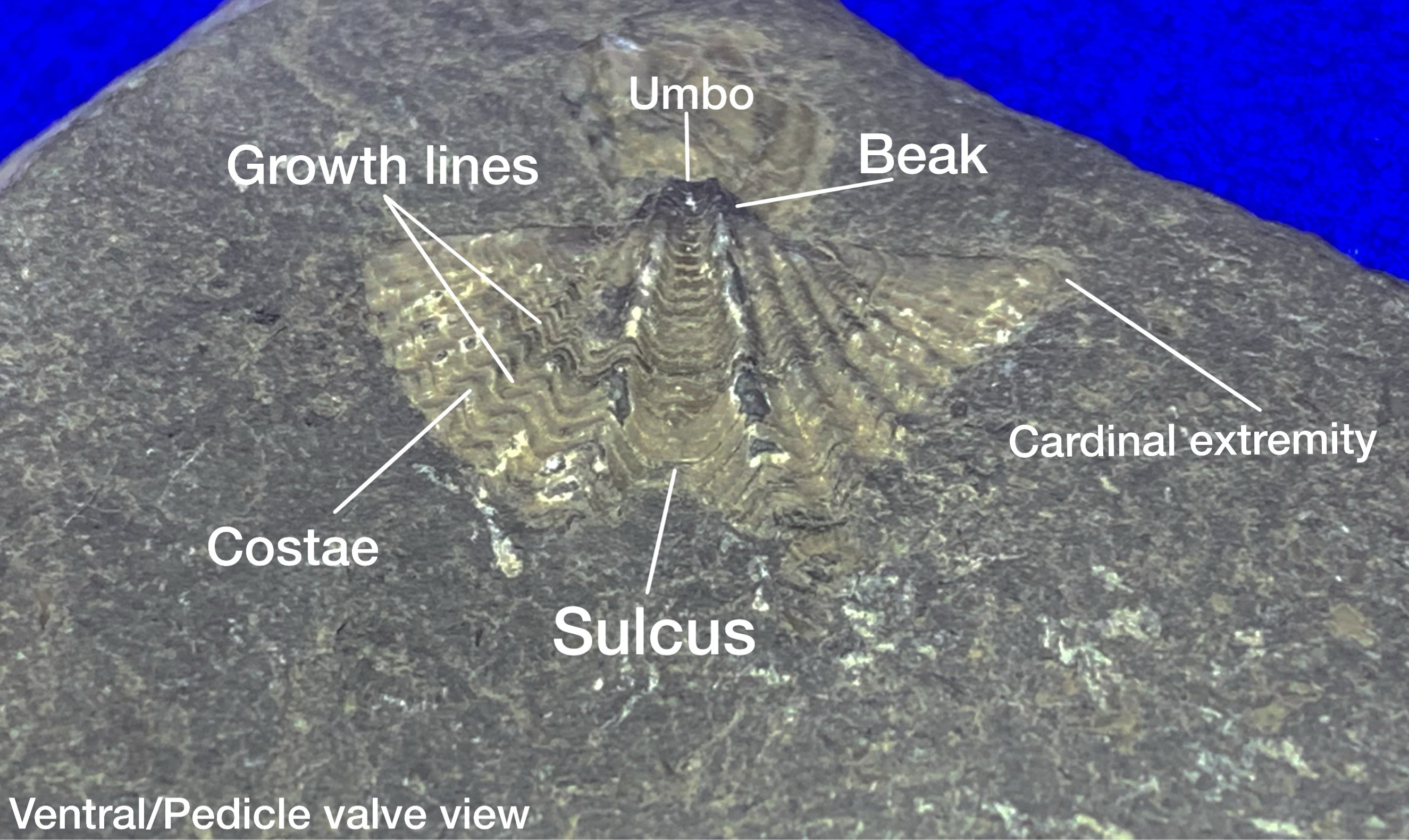|
Spiriferida
Spiriferida is an order of extinct articulate brachiopod fossils which are known for their long hinge-line, which is often the widest part of the shell. In some genera (e.g. ''Mucrospirifer'') it is greatly elongated, giving them a wing-like appearance. They often have a deep fold down the center of the shell. The feature that gives the spiriferids their name ("spiral-bearers") is the internal support for the lophophore; this ''brachidium'', which is often preserved in fossils, is a thin ribbon of calcite that is typically coiled tightly within the shell. Spiriferids first appear in the Late Ordovician with the appearance of ''Eospirifer radiatus''. They increased in diversity throughout the Silurian and underwent a dramatic evolutionary radiation during the Devonian period, reaching peak development in variety and numbers. Spiriferida survived the great Permian extinction (Albeit at much less diversity), finally becoming extinct during the Early to Middle Jurassic. Fossils of t ... [...More Info...] [...Related Items...] OR: [Wikipedia] [Google] [Baidu] |
Mucrospirifer
''Mucrospirifer'' is a genus of extinct brachiopods in the class Rhynchonellata (Articulata) and the order Spiriferida. They are sometimes known as "butterfly shells". Like other brachiopods, they were filter feeders. These fossils occur mainly in Middle Devonian Stratum, strata and appear to occur around the world, except in Australia and Antarctica. The biconvex shell was typically 2.5 cm long, but sometimes grew to 4 cm. The shell of ''Mucrospirifer'' has a fold, Sulcus (anatomy), sulcus and costae. It is greatly elongated along the hinge line, which extends outward to form sharp points. This gives them a fin- or wing-like appearance. The apex area (umbo) of the pedicle valve contains a small fold for the Brachiopod#pedicle, pedicle. ''Mucrospirifer'' lived in muddy marine sediments, and were attached to the sea floor via the pedicle. The shell sometimes looks like two seashells stuck together. Species *''Mucrospirifer albanensis'' *''Mucrospirifer arkonensis'' *' ... [...More Info...] [...Related Items...] OR: [Wikipedia] [Google] [Baidu] |
Eospirifer
''Eospirifer'' is a genus of extinct brachiopod in the class Rhynchonellata (Articulata) and the order Spiriferida. Their fossils occur most commonly in marine calcareous, microbialitic mudstones with extensive mudcracks or shelly packstones, generally mid-Silurian to early-Devonian The Devonian ( ) is a period (geology), geologic period and system (stratigraphy), system of the Paleozoic era (geology), era during the Phanerozoic eon (geology), eon, spanning 60.3 million years from the end of the preceding Silurian per ... in age. Select species *''Eospirifer radiatus'' *''Eospirifer dasifiliformis'' *''Eospirifer lachrymose'' *''Eospirifer praecursor'' References Silurian brachiopods Devonian brachiopods Prehistoric brachiopod genera Paleozoic brachiopods of Asia Silurian first appearances Early Devonian genus extinctions Fossils of Georgia (U.S. state) Paleontology in New Hampshire Paleozoic life of Ontario Paleozoic life of the Northwest Territories P ... [...More Info...] [...Related Items...] OR: [Wikipedia] [Google] [Baidu] |
Brachiopod
Brachiopods (), phylum (biology), phylum Brachiopoda, are a phylum of animals that have hard "valves" (shells) on the upper and lower surfaces, unlike the left and right arrangement in bivalve molluscs. Brachiopod valves are hinged at the rear end, while the front can be opened for feeding or closed for protection. Two major categories are traditionally recognized, articulate and inarticulate brachiopods. The word "articulate" is used to describe the tooth-and-groove structures of the valve-hinge which is present in the articulate group, and absent from the inarticulate group. This is the leading diagnostic skeletal feature, by which the two main groups can be readily distinguished as fossils. Articulate brachiopods have toothed hinges and simple, vertically oriented opening and closing muscles. Conversely, inarticulate brachiopods have weak, untoothed hinges and a more complex system of vertical and oblique (diagonal) muscles used to keep the two valves aligned. In many brachio ... [...More Info...] [...Related Items...] OR: [Wikipedia] [Google] [Baidu] |
Mucrospirifer Mucronatus
''Mucrospirifer mucronatus'' is a species of articulate brachiopod from the middle Devonian. The species serves as an index fossil for the middle Devonian. Discovery and history ''Mucrospirifer mucronatus'' was discovered by Timothy Abbott Conrad in 1841 as ''Delthyris mucronatus''. Until 1931, most species in the genus ''Mucrospirifer'' would be classified under the genus ''Spirifer''. Amadeus William Grabau Amadeus William Grabau (January 9, 1870 – March 20, 1946) was an American geologist, teacher, stratigrapher, paleontologist, and author who worked in the United States and China. Biography Grabau's grandfather, J.A.A. Grabau, led a group of ... would first propose the genus ''Mucrospirifer'' in 1931, using ''Mucrospirifer mucronatus'' as the type species. Description ''Mucrospirifer mucronatus'' typically has a biconvex shell. The shell is covered in ribs (known as costae). The cardinal extremities on the posterior are elongated in adolescent specimens to form spi ... [...More Info...] [...Related Items...] OR: [Wikipedia] [Google] [Baidu] |



